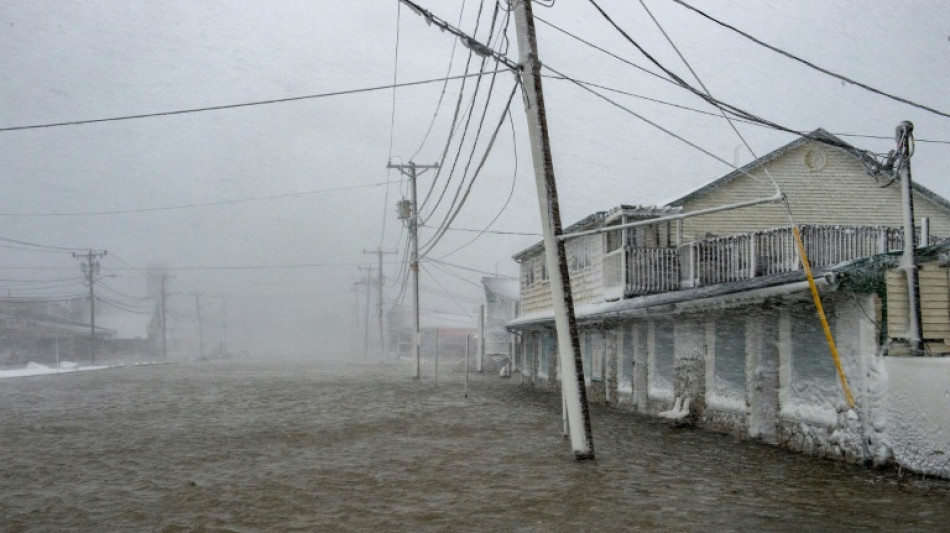
-
 Angry questions in Germany after Christmas market attack
Angry questions in Germany after Christmas market attack
-
China's Zheng pulls out of season-opening United Cup

-
 Minorities fear targeted attacks in post-revolution Bangladesh
Minorities fear targeted attacks in post-revolution Bangladesh
-
Tatum's 43-point triple-double propels Celtics over Bulls

-
 Tunisia women herb harvesters struggle with drought and heat
Tunisia women herb harvesters struggle with drought and heat
-
Trump threatens to take back control of Panama Canal

-
 India's architecture fans guard Mumbai's Art Deco past
India's architecture fans guard Mumbai's Art Deco past
-
Secretive game developer codes hit 'Balatro' in Canadian prairie province

-
 Large earthquake hits battered Vanuatu
Large earthquake hits battered Vanuatu
-
Beaten Fury says Usyk got 'Christmas gift' from judges

-
 First Singaporean golfer at Masters hopes 'not be in awe' of heroes
First Singaporean golfer at Masters hopes 'not be in awe' of heroes
-
Usyk beats Fury in heavyweight championship rematch

-
 Stellantis backtracks on plan to lay off 1,100 at US Jeep plant
Stellantis backtracks on plan to lay off 1,100 at US Jeep plant
-
Atletico snatch late win at Barca to top La Liga

-
 Australian teen Konstas ready for Indian pace challenge
Australian teen Konstas ready for Indian pace challenge
-
Strong quake strikes off battered Vanuatu

-
 Tiger Woods and son Charlie share halfway lead in family event
Tiger Woods and son Charlie share halfway lead in family event
-
Bath stay out in front in Premiership as Bristol secure record win

-
 Mahomes shines as NFL-best Chiefs beat Texans to reach 14-1
Mahomes shines as NFL-best Chiefs beat Texans to reach 14-1
-
Suspect in deadly Christmas market attack railed against Islam, Germany

-
 MLB legend Henderson, career stolen base leader, dead at 65
MLB legend Henderson, career stolen base leader, dead at 65
-
Albania announces shutdown of TikTok for at least a year

-
 Laboured Napoli take top spot in Serie A
Laboured Napoli take top spot in Serie A
-
Schick hits four as Leverkusen close gap to Bayern on sombre weekend

-
 Calls for more safety measures after Croatia school stabbings
Calls for more safety measures after Croatia school stabbings
-
Jesus double lifts Christmas spirits for five-star Arsenal

-
 Frankfurt miss chance to close on Bayern as attack victims remembered
Frankfurt miss chance to close on Bayern as attack victims remembered
-
NBA fines Celtics coach Mazzulla and Nets center Claxton

-
 Banned Russian skater Valieva stars at Moscow ice gala
Banned Russian skater Valieva stars at Moscow ice gala
-
Leading try scorer Maqala takes Bayonne past Vannes in Top 14

-
 Struggling Southampton appoint Juric as new manager
Struggling Southampton appoint Juric as new manager
-
Villa heap pain on slumping Man City as Forest soar

-
 Suspect in deadly Christmas market attack railed against Islam and Germany
Suspect in deadly Christmas market attack railed against Islam and Germany
-
At least 32 die in bus accident in southeastern Brazil

-
 Freed activist Paul Watson vows to 'end whaling worldwide'
Freed activist Paul Watson vows to 'end whaling worldwide'
-
Chinese ship linked to severed Baltic Sea cables sets sail

-
 Sorrow and fury in German town after Christmas market attack
Sorrow and fury in German town after Christmas market attack
-
Guardiola vows Man City will regain confidence 'sooner or later' after another defeat

-
 Ukraine drone hits Russian high-rise 1,000km from frontline
Ukraine drone hits Russian high-rise 1,000km from frontline
-
Villa beat Man City to deepen Guardiola's pain

-
 'Perfect start' for ski great Vonn on World Cup return
'Perfect start' for ski great Vonn on World Cup return
-
Germany mourns five killed, hundreds wounded in Christmas market attack

-
 Odermatt soars to Val Gardena downhill win
Odermatt soars to Val Gardena downhill win
-
Mbappe's adaptation period over: Real Madrid's Ancelotti

-
 France's most powerful nuclear reactor finally comes on stream
France's most powerful nuclear reactor finally comes on stream
-
Ski great Vonn finishes 14th on World Cup return

-
 Scholz visits site of deadly Christmas market attack
Scholz visits site of deadly Christmas market attack
-
Heavyweight foes Usyk, Fury set for titanic rematch

-
 Drone attack hits Russian city 1,000km from Ukraine frontier
Drone attack hits Russian city 1,000km from Ukraine frontier
-
Former England winger Eastham dies aged 88


Sea level projected to rise a foot on US coasts by 2050
The US coastline is expected to experience up to a foot (30 centimeters) of sea-level rise by the year 2050 because of climate change, making damaging floods far more common than today, a US government study said Tuesday.
The Sea Level Rise Technical Report combined tide gauge and satellite observations with climate modeling from the latest Intergovernmental Panel on Climate Change (IPCC) to make projections for the next 100 years.
It updates a 2017 technical report, providing new information on how tide-, wind- and storm-driven water levels affect current future flood risk.
The 111-page study predicted sea levels along the coastline will rise 10-12 inches between 2020-2050 -- as much rise over a 30-year period as the previous 100-year period of 1920-2020.
Specific amounts vary regionally, mainly due to land height changes.
"This new data on sea rise is the latest reconfirmation that our climate crisis -- as the President has said -- is blinking 'code red,'" said Gina McCarthy, National Climate Advisor, in a news release.
"We must redouble our efforts to cut the greenhouse gasses that cause climate change while, at the same time, help our coastal communities become more resilient in the face of rising seas."
The report also found that the sea level rise will drastically increase the rate of coastal flooding, even without storms or heavy rainfall.
"By 2050, moderate flooding -- which is typically disruptive and damaging by today's weather, sea level and infrastructure standards -- is expected to occur more than 10 times as often as it does today," said Nicole LeBoeuf of the National Oceanic and Atmospheric Administration, which led the report that was co-authored by half a dozen agencies.
Moderate floods that now occur every two to five years would happen multiple times in a single year.
Higher sea levels are caused by the melting ice sheets and glaciers and the expansion of seawater as it warms, and are linked to higher global temperatures.
About two feet of sea level rise is thought increasingly likely between 2020 and 2100 because of greenhouse gas emissions seen to date, the report said.
But failing to curb future emissions could cause an additional 1.5 to five feet of rise, for a total of 3.5 to seven feet by the end of the century.
Above 5.5 degrees Fahrenheit (three degrees Celsius) warming might cause much higher sea level rise because of the potential for rapid melting of ice sheets in Greenland and Antarctica, but the precise level is uncertain because of current model limitations.
Expanding monitoring through satellite tracking of sea levels and ice sheet thickness will be critical to improving models and helping inform adaptation plans, the report said.
"For businesses along the coast, knowing what to expect and how to plan for the future is critical," said Secretary of Commerce Gina Raimondo.
L.E.Campos--PC




